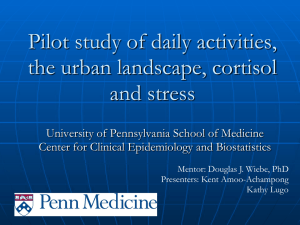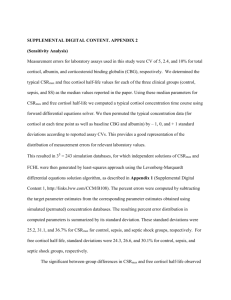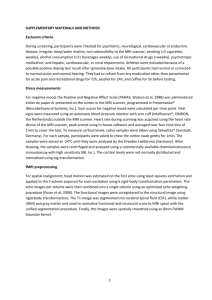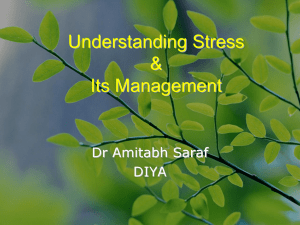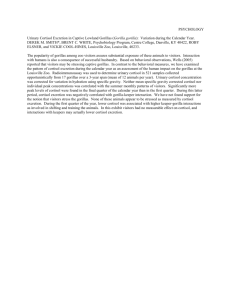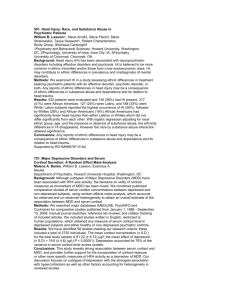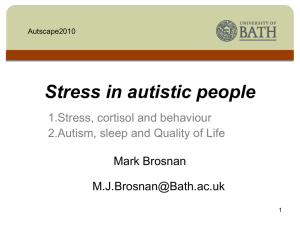The prognostic value of cortisol measured by liquid chromatography
advertisement
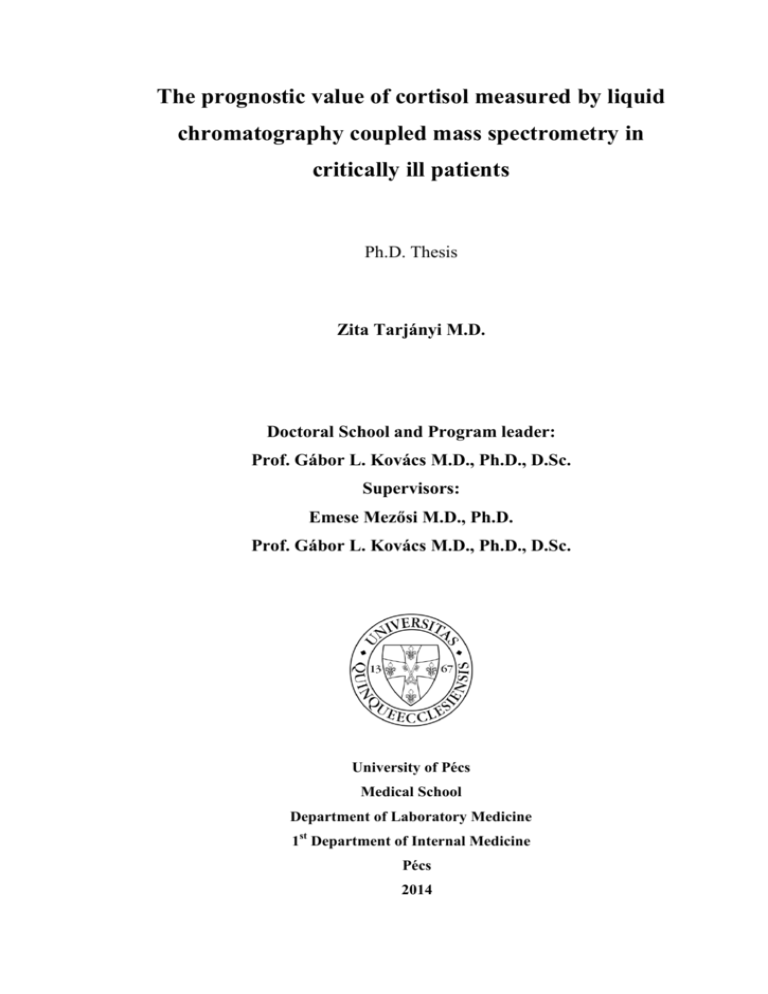
The prognostic value of cortisol measured by liquid chromatography coupled mass spectrometry in critically ill patients Ph.D. Thesis Zita Tarjányi M.D. Doctoral School and Program leader: Prof. Gábor L. Kovács M.D., Ph.D., D.Sc. Supervisors: Emese Mezősi M.D., Ph.D. Prof. Gábor L. Kovács M.D., Ph.D., D.Sc. University of Pécs Medical School Department of Laboratory Medicine 1st Department of Internal Medicine Pécs 2014 1 1.1 Introduction Measurement of cortisol Cortisol is a glucocorticoid hormone produced in the zona fasciculata of the adrenal gland. Approximately 90% of circulating cortisol is bound to proteins, whereas the remaining 10% is present in an unbound, free form. The bound fraction is distributed between corticosteroid binding globulin (CBG) and albumin. Only the free fraction is physiologically active. Cortisol is present in blood, urine and saliva; the latter clearly reflects blood free-cortisol status. Most routine laboratory methods measure total cortisol (TC) concentration, but the measurement of free cortisol (FC) provides more informative results. Alterations in albumin and CBG concentrations might adversely affect results. Possible ways of estimating FC cover two different approaches. One is to calculate FC mathematically, by quantifying TC and CBG and then evaluating FC using the free serum cortisol index or the Coolens formula. The main problems with these approaches are that they do not consider inter-individual variations in binding characteristics, and that the possible errors of the measurements might accumulate. The other option is to measure FC directly. The assay starts with the mechanical removal of the protein fraction to obtain a protein free preparation: this is commonly performed by equilibrium dialysis or, as a faster alternative, by ultrafiltration. The latter requires an ultrafiltration device equipped with a membrane having a molecular weight cut-off value more than the weight of the analyte, but less than the weight of CBG and albumin. A simpler method of establishing unbound, circulating cortisol status is measuring salivary cortisol (SC), because this does not require the removal of any protein fraction. Analytical tools used for FC and SC estimation are similar to those used for the measurement of TC. The only difference is that TC assays contain a hormone displacement to liberate the protein-bound fraction. The routinely used immunoassays, for example enzyme immunoassays (EIA) and electrochemiluminescence assays (ECLIA), have high sensitivity and are used on different matrices. The major challenge of immunoassays is specificity, because steroid compounds have high structural similarity, resulting in potential cross reactivity. This is especially problematic if the patient receives a common prednisolone or methylprednisolone treatment, which can lead to fals results. A 2 series of further steroids were reported to crossreact with antibodies raised against cortisol. Immunoassays carry further analytical problems, namely the antibody interferences (heterophilic antibodies or autoantibodies). Mass spectrometry coupled with high-performance liquid chromatography (HPLC-MS) has higher specificity than immunoassays because identification is on the basis of the compound’s mass-to-charge ratio, instead of structural characteristics. This enables the differentiation and specific quantification of structurally highly similar compounds. No analytical error from cross reactivity and heterophilic antibodies are expected using HPLC. It allows analysis of multiply metabolites from small sample volume. However, HPLC-MS requires rigorous validation. 1.2 Endocrine changes in critical illness Critical illness is a life-threatening condition due to serious illnesses, infections, surgery or trauma manifested in vital organ failure and severe physical stress. Support of insufficient organ systems is essential for survival. These patients might not survive without the new therapeutic options of critical care medicine. The critical illness is associated with neuroendocrine and metabolic alterations such as central and peripheral endocrine stress reactions. The lifethreatening condition is the ultimate form of severe physical stress. In recent years novel data accumulated about the pathomechanism of endocrine responses in critical illness. 1.3 Endocrine predictors of poor prognosis in critically ill patients In the clinical practice, validated scoring systems are used in the critical care medicine to predict the outcome of individual patients: acute physiology and chronic health evaluation (APACHE), simplified acute physiology score (SAPS), etc. These scores use multiple parameters of vital functions, laboratory tests and patient characteristics. There were numerous attempts to find biomarkers of adverse outcome. Many hormones were investigated from this point of view. In the acute phase of critical illness, low cortisol response to adrenocorticotropic hormone (ACTH) stimulation and high baseline serum cortisol levels were reported as indicators of poor prognosis. The elevated reverse triiodothyronine (rT3) and T3/rT3 ratio were also found as markers of high mortality risk. Estradiol levels at admission 3 and later independently associated with mortality in a large population of critically ill patients. High ghrelin levels were found as positive predictor at intensive care unit (ICU) survival in septic patients. ICU-survivors had significantly lower brain natriuretic peptid (BNP) concentrations when compared to non-survivors in a large unselected cohort of critically ill patients. Increased plasma adiponectin level was also reported being associated with mortality in patients with respiratory failure. Median growth hormone (GH) concentrations at admission increased about 7-fold in non-survivors as compared with survivors. It should be concluded from many studies that the magnitude of expected endocrine changes is higher in patients with more severe disease and high risk of mortality, and a number of hormonal parameters can be useful in predicting the prognosis of individual patients. 2 2.1 Aims Validation of a new method for cortisol measurement Our objective was to develop a sensitive and specific HPLC-MS-based cortisol assay using a Bruker micrOTOF high-resolution mass spectrometer. The development of the assay was planned for the measurement of a) total serum cortisol b) free serum cortisol c) salivary cortisol 2.2 Cortisol response measured by HPLC-MS in critical illness The aim of this study was a) to analyze the total and free cortisol concentrations measured by HPLC-MS in a mixed population of critically ill patients with medical emergencies b) to determine the time course of cortisol response in critical illness c) to estimate the prognostic role of cortisol levels in comparison to APACHE II and SAPS II mortality scores which are the best known predictors of mortality d) to evaluate serum total and free cortisol concentrations as new prognostic biomarkers in critical illness 4 3 3.1 Patients and Methods Chemicals and standards All analytical standards were purchased from Sigma-Aldrich, Budapest, Hungary, except the deuterated internal standard (IS), (9,12,12-D3 cortisol), which was purchased from Cambridge Isotope Laboratories Inc. (USA). All solvents were of HPLC-MS grade, purchased from Molar Chemicals (Molar Chemicals, Hungary). 3.2 Patients during the validation of HPLC-MS cortisol measurement The total number of patients involved was 292, with a gender distribution of 175 females and 117 males. The mean age of the female patients was 59.1 years (2382 years) and that of the males was 53.4 years (24-76 years). All blood samples were collected in anticoagulant-free Vacutainer (Becton Dickinson, Hungary) plastic tubes. Sampling was performed from 8:30 am to 10:00 am and sera samples were kept frozen at -24 °C until sample preparation. Salivary samples were collected from healthy volunteers by using Salivette Cortisol devices (Saarstedt, Hungary). Samples were stored frozen until the measurement. 3.3 Sample preparation TC samples were treated as follows: 20 μL internal standard solution (1.1 μmol/L) was added to 100 μL serum. Afterwards, 300 μL acetonitrile was added for protein precipitation, followed by centrifugation at 14000g for 10min. 50 μL upper phase was added to 50 μL water in an autosampler. 20 μL of this mixture was injected onto the HPLC column. To analyze FC, 500 μL serum was ultrafiltrated, using 30000 Da molecular weight cut-off Amicon Ultra-0.5 mL centrifugal filters (Merck, Hungary). Saliva samples and serum ultrafiltrate were further processed with solid phase extraction (SPE). 20 μL internal standard solution (0.11 μmol/L) was added to 400 μL saliva or ultrafiltrate. Extraction was performed on Strata-X (60 mg) polymeric reversed-phase extraction cartridges (Phenomenex, USA). The eluate was dried under vacuum, and the residue was redissolved in 20% methanol in water containing 2 mmol/L ammonium acetate and 0.05% formic acid. The injection volume was 20 μL. 5 3.4 Instrumentation A Dionex Ultimate 3000 (Dionex, USA) analytical HPLC equipped with an autosampler and a column thermostat set at 30 °C was used. Separation was performed on a Kinetex C8 2.6 μm, 2.1×100 mm analytical column (Phenomenex, USA) with a multi-step gradient elution at a flow of 200 μL/min. HPLC solvents contained 2 mmol/L ammonium acetate and 0.05% formic acid in 5% (A) and 95% (B) acetonitrile. The mass spectrometer coupled to the HPLC was a Bruker micrOTOF accurate mass instrument, equipped with an electrospray ionization (ESI) source operated in the positive mode. Main source settings were: capillary voltage: 4500 V, nebuliser pressure: 2.4 bar, drying gas flow (nitrogen): 8 L/min, and drying temperature: 210 °C. Mass spectra were collected between m/z 200 and m/z 500. Internal mass calibration was performed at the beginning of every run. 3.5 Critically ill patients The prospective, observational study was carried out in 69 non-selected patients admitted to the Intensive Care Unit of the 1st Department of Internal Medicine, University of Pécs, Hungary. Gender distribution was the following: 39 males and 30 females, median age was 74 (23-87) years. It was a mixed population of patients with medical emergencies, no surgical or trauma patients were included. Vital signs, clinical status and routine laboratory parameters were monitored. The treatment of patients was thoroughly evaluated and blood samples disturbed by glucocorticoid treatment were excluded from the further analysis. None of the patients received etomidate, ketoconazole or any other drug influencing the steroid metabolism. The severity of the diseases was scored according to the SAPS II and the APACHE II. Blood samples were taken at admission (0 hour), 6, 24, 48 and 96 hours after admission. Concentrations of free and total cortisol were measured by high performance liquid chromatography (HPLC) coupled high resolution electrospray ionization-time of flight (ESI-TOF) mass spectrometry. 6 3.6 Statistics Statistical analysis was performed using the IBM SPSS Statistics Version 20 (IBM Magyarország Kft. Budapest, Hungary) and SPSS Statistics Version 22.0 (SPSS, Inc., Chicago, IL, USA) softwares. Kolmogorov-Smirnov test was used to determine the distribution of the data. Significant results were those with P values < 0.05. Total and free cortisol levels of survivors and non-survivors were compared using Mann-Whitney U test. Relationships between non-normally distributed quantitative variables were evaluated by Spearman correlation. The diagnostic value of cortisol levels to predict mortality was determined by receiver operating characteristic (ROC) analysis. The optimal cut-off point was assessed using Youden’s J statistic. Kaplan-Meier survival curves were created to compare the mortality risk in cortisol quartiles. Independent determinants of mortality were investigated by binary logistic regression analysis. 4 Results 4.1 4.1.1 Establishment of a new method for cortisol measurement using HPLC-MS HPLC coupled ESI-TOF detection The retention time of cortisol and the IS was consistent at 6 min (±0.1 min). The mass width was set at ±0.001 Da (1 mDa) for all measurements. The m/z value of the extracted ion chromatogram (EIC) was chosen according to the observed masses of cortisol (m/z 363.2099) and the IS (m/z 366.2287). Both masses correspond to the proton adduct ions [M+H]+. A mass accuracy of 1-2.5 ppm was achieved throughout the whole set of measurements. Because of the high mass accuracy achieved, the narrowest mass window (±1 mDa) was used on all chromatograms. During the validation of HPLC-MS cortisol measurement the following concentration ranges were established from the processed samples: TC 35.6-1088 nmol/L (average 372 nmol/L), FC 0.5-12.4 nmol/L (average 3.7 nmol/L), SC 0.710.4 nmol/L (average 3.2 nmol/L). 4.1.2 Method validation Intra-assay and inter-assay variations were determined using a total of nine pooled sample lots constructed for the three assays (TC, FC and SC). Every pooled 7 lot was composed of ten randomly chosen samples. One was constructed in the low range (TC <100 nmol/L, FC and SC <3 nmol/L), one in the middle range (TC 100500 nmol/L, FC and SC 3-8 nmol/L), and one in the high range (TC >500 nmol/L, FC and SC >8 nmol/L). Every material was assayed 20 times. Inter-assay variation was estimated by six repeated analyses of the respective material on consecutive days. Intra-assay coefficient of variation (CV) was best with the 254.5 nmol/L TC pool, at 1.7%, and worst with the 45.8 nmol/L TC pool, at 7.4%. We observed the worst inter-assay CV with the 254.5 nmol/L TC pool, at 9.6%, and the best with the 8.4 nmol/L SC pool, at 4.1%. The average intra-assay CV was 4.7%, and the average inter-assay variance was 6.6%. Limit of detection (LOD) and limit of quantification (LOQ) were determined using sera and saliva samples diluted with PBS (phosphate buffered saline) till the achievement of a three (LOD) or ten (LOQ) times average signal-to-noise ratio. The values of LOQ and LOD were determined from the results of 10 repeated analyses of the corresponding material. The LOD and LOQ were similar for FC (LOD 140 pmol/L, CV 8.9%, LOQ 440 pmol/L, CV 6.6%) and SC (LOD 190 pmol/L, CV 9.1%, LOQ 600 pmol/L, CV 7.1%) samples, but much higher for TC (LOD 9 nmol/L, CV 7.8%, LOQ 12.5 nmol/L, CV 6.5%). The assay was linear from 400 pmol/L-4000 nmol/L nominal concentration. Recovery was calculated by determining the cortisol concentration of pooled samples (n=5) before and after addition of a known amount of cortisol. We observed a mean recovery of 101.2% for TC, and of 98.9% and 94.6% for FC and SC, respectively. Calculated recovery values ranged from 94.6-107.8%. 4.1.3 Investigation of method interference with frequently used steroid drugs Interference studies were performed using pooled samples spiked with solutions of frequently used steroidal drugs to achieve a final concentration of 5000 nmol/L of the added drug. Every spiking experiment was repeated ten times. Cortisol concentrations of the samples were measured before and after the addition of the corresponding drugs. Cortisone, dexamethasone, prednisone, and methylprednisolone were chromatographically separated from cortisol and no interference was observed. Prednisolone, however, had the same retention time as cortisol and the IS. We observed an average 3% (2.2-4.1%, n=10) overestimation of cortisol concentration, which is less than the average CV observed during the study. 8 With our HPLC-ESI-TOF method, after internal calibration of each sample run a ±0.001 Da (1 mDa) mass width was obtainable on the EICs. For the masses of cortisol (362.2093 Da) and the IS (365.2282 Da), the calculated mass accuracy was always <2.5 ppm. Conventionally, a measurement is regarded as an “accurate mass measurement” if the maximum mass error is less than or equal to 2.5 mDa and the mass accuracy is not higher than 5 ppm, or more recently, 3 ppm. 4.1.4 Comparison of the HPLC-MS method with commonly used immunoassays in non-critically ill patient population Method comparison was performed using three different immunoassays. Results of the TC measurements were compared with the Roche Modular Analytics E 170 ECLIA assay (n=96), the validated method used in our laboratory. Results of the FC and SC measurements (n=96 in both cases) were compared with the results of two commercially available immunoassay kits. The Enzo Cortisol EIA kit (Biomarker, Budapest, Hungary) was used for parallel FC measurements, and the IBL International Cortisol ELISA kit (Diagnosticum, Budapest, Hungary) for SC measurements. Results of the HPLC-MS assay were compared with the results of the reference methods by Pearson correlation and linear regression analysis. A notable positive bias was observed in the higher concentration ranges for FC and SC measurements; however, we did not observe this when comparing results of the TC analysis. The value of the Pearson correlation coefficient was similar for the TC and SC results (0.991 and 0.992 p<0.001); however, the FC results were lower than those estimated using the EIA kit (0.987 p<0.001). 4.2 4.2.1 Total and free cortisol measurements in critically ill patients Cortisol response in critical illness and the correlation of total and free cortisol levels The range of TC varied between 49.9 and 8797.8 nmol/L (reference range: 138-690 nmol/L) with a median (interquartile ranges) of 583.5 (381.5/855.8) nmol/L, FC between 0.4 and 759.9 nmol/L (reference range: 1-8 nmol/L) with a median (interquartile ranges) of 13.4 (4.3/60.1) nmol/L. The maximal elevation of TC was 13 times, of FC was 95 times of the upper limit of reference range (ULN). The cortisol levels did not show normal distribution. TC and FC levels significantly correlated (P<0.001) (R=0.710). 9 Total cortisol at admission was significantly higher than later and at 6 hours was also elevated compared to later time points. Free cortisol was significantly elevated only at admission compared to later measurements. 4.2.2 Comparison of cortisol values in survivor and non-survivor population The total and free cortisol levels of survivors (n=51) and non-survivors (n=18) (30-day mortality) were compared. Elevated TC was found in non-survivors at 0, 6 and 48 hours. FC was significantly higher in non-survivors at admission and 6, 24 and 48 hours after admission. Because intubation and mechanical ventilation may increase cortisol levels and may be associated with bad prognosis, the cortisol levels of ventilated and not ventilated patients were also compared at every time points. TC at admission (TC0) (p=0.001), FC at admission (FC0) (p<0.001) and FC at 6 hours (FC6) (p=0.001) were significantly higher in ventilated patients. The mortality rate was also significantly elevated in cases that required ventilation (p<0.001). 4.2.3 The predictive role of cortisol concentrations at different time points for mortality The predictive role of cortisol levels was investigated in comparison to the well accepted clinical scores, APACHE II and SAPS II mortality. FC at 0 (FC0), 6 (FC6), 24 (FC24), 48 (FC48) and 96 hours (FC96) significantly correlated with predicted mortalities. TC at 0 (TC0) and 6 hours (TC6) also correlated with mortality scores but the correlation disappeared from TC at 24 hours (TC24). The diagnostic value of cortisol concentrations to predict mortality was next evaluated by ROC analysis. The cut-off values of cortisol with optimal diagnostic accuracy were determined. The FC0 and TC0 had higher sensitivity and lower specificity than the later values. The sensitivity and specificity of APACHE II and SAPS II mortality was similar to the diagnostic value of FC6, FC24 and FC48. The best separation of survival in Kaplan-Meier curves was found at FC0 analyzed in quartiles. Patients with the lowest 25% of free cortisol all survived while 60% of patients died in the highest quartile (>75%). 10 4.2.4 Mortality predicting models using total and free cortisol concentrations Based on this excellent prognostic role of cortisol levels, they were included in mortality predicting models together with gender, age and the complex clinical scores, APACHE II and SAPS II mortality. FC6, FC24 and FC48 turned to be independent determinants of mortality beside APACHE II and SAPS II. The sensitivity and specificity of these models were surprisingly high. It is notable that the clinical scores created by 12 or 17 parameters and the cortisol as a single parameter are comparable in their predictive roles. The contribution of intubation and mechanical ventilation per se to cortisol elevation is difficult to estimate. To approach this question, the role of ventilation, mortality scores, gender, age and cortisol levels were investigated in binary logistic regression models. The need for ventilation was very strong determinant of mortality, even stronger than the mortality scores. However, FC6, FC24 and FC48 remained independent determinant of mortality beside ventilation. These data confirms that the intubation and ventilation themselves may, at least partly be responsible for the significant differences in cortisol levels of survivor and non-survivor patient population. 5 5.1 Discussion Establishment of a new method for cortisol measurement using HPLC-MS Commonly, targeted mass-spectrometry analysis is carried out using triple- quadrupole mass spectrometers. The advantage of these instruments is their ability to perform fragmentation of the analyte, providing a significant fragmentation pattern. Specific quantification is performed by integrating the fragment-ion peaks instead of the parent mass. The other way of achieving specific mass-spectrometry molecular identification is using the accurate monoisotopic mass of the molecule instead of performing fragmentation before detection. The accurate theoretical monoisotopic mass of a molecule is a result of its elemental composition. If we can improve mass accuracy we can determine lower mass differences between two molecules. As a result, specificity increases, because we are able to exclude molecules having similar molecular mass but different elemental compositions. The other consequence of high mass accuracy is the possibility of using a narrow mass window on the EIC. 11 Quantification in our method was performed using a 5.5 ppm-wide mass window, with no interference observed even with coeluting compounds of similar mass. This is a very important aspect when developing an alternative method to immunoassays, because the major advantage of mass spectrometry over immunoassays is the higher specificity. Steroids administered as therapeutic drugs often cross-react with antibodies raised against cortisol. During the validation of the HPLC-MS method, LOD and LOQ values were first established. The LOQs for FC (440 pmol/L), SC (600 pmol/L) and TC (12.5 nmol/L) are well below the ranges commonly observed under physiological conditions (1-8 nmol/L FC and SC, 100-800 nmol/L TC); however, that for TC is much higher than for the two other assays. This is because TC has a relatively high concentration range, well within the sensitivity of mass spectrometry, so there was no need to use SPE sample concentration. Instead, a simple protein precipitation with acetonitrile was suitable, as seen from the results of the recovery, variation, and ion suppression measurements. Comparison with the immunoassays resulted in a positive bias in the higher concentration ranges for TC and SC. We assume that this is caused by crossreactions of the immunoassays with other matrix compounds. Usually our method underestimated cortisol compared with the results of all three immunoassays; this was less notable when comparing the results with the validated clinical Roche Modular E 170 ECLIA assay. We observed the best correlation of our results with the results of this immunoassay. During the analysis of the TC, FC, and SC samples, observed concentration ranges were similar to the values established in other studies. However, the mean concentration of our samples was slightly higher (TC 372 nmol/L, FC 3.7 nmol/L, and SC 3.6 nmol/L) than those described in other papers (TC <300 nmol/L, FC and SC <3 nmol/L). This might be because our sampling was performed in the morning hours. 5.2 Cortisol levels are useful prognostic markers in critically ill patients In this prospective observational study, total and free cortisol levels were determined by HPLC-MS in the serum of critically ill patients with medical emergencies. An extremely wide range of cortisol concentrations were found upward exceeding the upper limit of normal by 13 times in total and 95 times in free cortisol 12 levels. Both total and free cortisol levels were elevated at admission compared to later time points. Free cortisol within 2 days and total cortisol within 6 hours correlated with the observed mortality. Patients with higher cortisol levels had higher risk to die. The requirement for ventilation may be partly responsible for the higher cortisol levels in non-survivors. The diagnostic value of cortisol concentrations to predict mortality was similar to the routinely used clinical mortality scores (APACHE II, SAPS II). Furthermore, FC6, FC24 and FC48 proved to be independent determinants of mortality even in predicting models including – beyond gender and age – these complex clinical scores. Information provided by these cortisol levels as single parameters about the prognosis were similar to complex mortality scores that have been formed by 12 and 17 parameters, respectively. There are some key reports investigating the total serum cortisol in critically ill patients. Free cortisol levels were measured in few papers and sparse data are available about free cortisol determined by HPLC-MS. Only one paper is available where both total and free cortisol levels were measured by HPLC-MS/MS in septic shock. Cortisol measurements using immunoassays are disturbed by many analytical errors, especially in critically ill patients. The changes in CBG and albumin concentrations, the cross-reactivity of antibodies to similar chemical structures and heterophilic antibodies all influence the results. These potential errors are eliminated by HPLC-MS method. Our cortisol method using HPLC-MS was previously validated in normal subjects. The method is capable of specific cortisol quantification in different matrices on the basis of accurate mass identification. The measurement of total cortisol is quite simple and accurate; therefore nowadays this method is used routinely for this purpose in our institute. The measurement of free cortisol requires more complex sample preparation which is a disadvantage in the everyday routine. Considering all these factors, free cortisol measured by HPLC-MS is the best method to evaluate the adrenal response in critically ill patients but for prognostic purposes total cortisol measured by HPLC-MS seems to be more available in the daily practice. Beyond the practical consequences, our results have theoretical aspects. The cortisol response to medical emergencies seems to be proportional to the severity of illness. It can be presumed that the adrenal response is appropriate and maximal in life-threatening conditions. It is not clear whether the cortisol level should be further increased by ACTH stimulation. According to a new concept of cortisol homeostasis 13 in critical illness, ACTH is not elevated, even suppressed due to the high cortisol level. It is possible that ACTH stimulation test does not result in significant cortisol elevation in those patients who already have high cortisol level. They are regarded having relative adrenal insufficiency. The overproduction of cortisol is also debated. The primary cause of cortisol elevation probably is the decreased metabolism of glucocorticoids. The concept of relative adrenal insufficiency (RAI) should be reappraised based on these new studies. Our results did not support the existence of RAI and its role in the poor prognosis of critically ill patients. Further investigations are essential in patients with unresponsive septic shock where the high dose hydrocortisone treatment is a routine therapy. 6 Conclusions In conclusion, our HPLC-MS assay based on accurate ESI-TOF mass detection proved to be a real alternative to the common triple-quadrupole MS assays, with less complicated method development. The performance of the method was demonstrated on three clinically important laboratory variables. The only potential disadvantage of our method is that a triple-quadrupole instrument usually offers higher sensitivity. However, the LOD and LOQ achieved in this work are much lower than accepted and described physiological ranges. Using an accurate mass spectrometry instrument, a high number of different compounds can be monitored in a single analytical run. The total and free cortisol concentrations in critically ill patients varied in so wide range, that the highest total cortisol exceeded 13 times, free cortisol 95 times of the upper limit of reference range. Both total and free cortisol levels measured by HPLC-MS were useful prognostic markers, patients with higher cortisol levels had higher mortality risk. Free cortisol had an advantage compared to total cortisol being predictive for mortality in the first 2 days after admission. Free cortisol at 6, 24 and 48 hours proved to be independent predictor of mortality in prognostic models even including the SAPS II and APACHE II mortality scores. Cortisol levels in critical illness probably reflect the severity of disease. 14 7 Novel findings 1) We have validated a novel HPLC-MS method for measurement of a) serum total cortisol b) serum free cortisol c) salivary cortisol. 2) Our method is capable of specific cortisol quantification in different matrices on the basis of accurate mass identification. The measurement of total cortisol is quite simple, accurate and cost-effective; therefore nowadays this method is used routinely in our institute. 3) Our study was the first where both total and free serum cortisol levels were measured by HPLC-MS in a mixed population of critically ill patients with medical emergencies. 4) We have proven that serum total and free cortisol concentrations measured by HPLC-MS are able to predict morality and reflect the severity of disease. Consequently both of them could be a useful prognostic marker in critical illness. 5) Our data support that the prognostic value of cortisol concentrations to predict mortality was similar to the routinely used clinical mortality scores (APACHE II and SAPS II) which are the best known predictors of mortality. 6) Our data also demonstrated that critically ill patients with higher cortisol levels had higher mortality risk and that cortisol levels at different time points of the critical condition proved to be independent determinants of mortality. 7) These findings could help the application of new prognostic biomarkers in critical illness. 15 Publications related to the thesis Montskó G*, Tarjányi Z*, Mezősi E, Kovács GL: A validated method for measurement of serum total, serum free, and salivary cortisol, using highperformance liquid chromatography coupled with high-resolution ESI-TOF mass spectrometry. Anal Bioanal Chem 2014;406:2333-2341 *due to their equal contribution, both authors are considered as first authors IF: 3.659 Tarjányi Z, Montskó G, Kenyeres P, Márton Zs, Hágendorn R, Gulyás E, Nemes O, Bajnok L, Kovács GL, Mezősi E: Free and total cortisol levels are useful prognostic markers in critically ill patients: a prospective observational study. Eur J Endocrinol 2014;171:751-759 IF: 3.686 Publications not discussed in the thesis Nemes O, Kovács N, Czeiter E, Kenyeres P, Tarjányi Z, Bajnok L, Büki A, Dóczi T, Mezősi E: Predictors of post-traumatic pituitary failure during long term endocrine follow-up Accepted for publication in Hormones IF: 1.237 Nemes O, Csiszár A, Rucz K, Bajnok L, Bódis B, Gulyás E, Tarjányi Z, Nagy Zs, Dóczi T, Mezősi E: A hypophysisadenomás betegek gondozásával szerzett tapasztalataink. Magyar Belorvosi Archívum 2011;(64)5:273-278 Presentations and posters related to the thesis Tarjányi Z, Montskó G, Mezősi E, Kovács GL: Összkortizol szint mérés LC-ESI TOF tömegspektrometriával humán szérumban. 24th Congress of the Hungarian Society of Endocrinology and Metabolism, Szolnok, 2012. 16 Montskó G, Tarjányi Z, Mezősi E, Kovács GL: Vér össz-, szabad, valamint nyál kortizol hormon szintek meghatározása LC-ESI TOF tömegspektrometriával. 42nd Membrane Transport Conference, Sümeg, 2012. Tarjányi Z, Montskó G, Mezősi E, Kovács GL: Measurement of serum total cortisol using high performance liquid chromatography coupled ESI-TOF mass spectrometry. From Medicine to Bionics, 1st European PhD Conference, Budapest, 2013. Tarjányi Z, Montskó G, Mezősi E, Kovács GL: Measurement of serum total cortisol using HPLC coupled ESI-TOF mass spectrometry. 16th European Congress of Endocrinology, Wrocław, 2014. Tarjányi Z, Montskó G, Kenyeres P, Márton Zs, Hágendorn R, Gulyás E, Nemes O, Bajnok L, Kovács GL, Mezősi E: A kortizol hasznos prognosztikai marker kritikus állapotú betegekben. 25th Congress of the Hungarian Society of Endocrinology and Metabolism, Pécs, 2014. 17 Acknowledgements First and foremost I would like to express my gratitude to my mentor, Emese Mezősi, for her encouragement and support throughout my PhD studies. She originated a perfect atmosphere for learning and working and gave me invaluable advices to both academic and personal life. I am really thankful for the great help of Professor Gábor L. Kovács, my esteemed supervisor for supporting my research. I would like to thank the successful joint work and the unlimited help for Gergely Montskó, who introduced me the method of mass spectrometry, and who facilitated to use a completely new method for our study. I would also like to acknowledge the constant guidance and support of Professor László Bajnok, who helped me to the implementation and explanation of clinical studies. I am grateful for the help of my immediate colleagues, Orsolya Nemes, Beáta Bódis, Károly Rucz and Zsuzsanna Keszthelyi, and I thank the help of the student researchers, assistants, nurses and coworkers of both the Ist Deparment of Internal Medicine and Department of Laboratory Medicine of the University of Pécs. Last but not at least, I would like to thank my family, as well as my friends for their continuing support and patience throughout the years. 18
